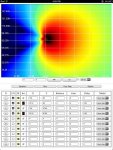For all you guys using prediction software I need to clear up something. After reading some of Bennett's articles I ran across an iPad app that does acoustic predictions. It's only does Omnidirectional Subs, but that's all I need it to do.
I was able to get the exact cardioid shape that I want from a block of four subwoofers by placing them a quarter wavelength apart on the grid, reversing the polarity and adding 2 ms of delay. I'm assuming that it's 2ms since the only parameter you can change is whether or not you want the field in feet or meters.
So, here's my question... if I were to take this prediction and put it into a real world scenario... Is the 2ms of delay assuming that the phase has already been aligned/corrected so the additions are going to be perfect? Or would I just add the 2ms and go with it?

I was able to get the exact cardioid shape that I want from a block of four subwoofers by placing them a quarter wavelength apart on the grid, reversing the polarity and adding 2 ms of delay. I'm assuming that it's 2ms since the only parameter you can change is whether or not you want the field in feet or meters.
So, here's my question... if I were to take this prediction and put it into a real world scenario... Is the 2ms of delay assuming that the phase has already been aligned/corrected so the additions are going to be perfect? Or would I just add the 2ms and go with it?

